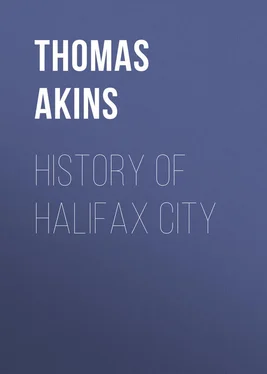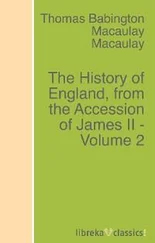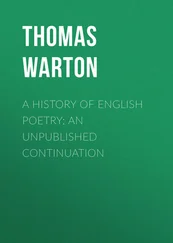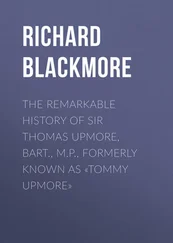Thomas Akins - History of Halifax City
Здесь есть возможность читать онлайн «Thomas Akins - History of Halifax City» — ознакомительный отрывок электронной книги совершенно бесплатно, а после прочтения отрывка купить полную версию. В некоторых случаях можно слушать аудио, скачать через торрент в формате fb2 и присутствует краткое содержание. Жанр: foreign_antique, foreign_prose, Историческая проза, на английском языке. Описание произведения, (предисловие) а так же отзывы посетителей доступны на портале библиотеки ЛибКат.
- Название:History of Halifax City
- Автор:
- Жанр:
- Год:неизвестен
- ISBN:нет данных
- Рейтинг книги:3 / 5. Голосов: 1
-
Избранное:Добавить в избранное
- Отзывы:
-
Ваша оценка:
- 60
- 1
- 2
- 3
- 4
- 5
History of Halifax City: краткое содержание, описание и аннотация
Предлагаем к чтению аннотацию, описание, краткое содержание или предисловие (зависит от того, что написал сам автор книги «History of Halifax City»). Если вы не нашли необходимую информацию о книге — напишите в комментариях, мы постараемся отыскать её.
History of Halifax City — читать онлайн ознакомительный отрывок
Ниже представлен текст книги, разбитый по страницам. Система сохранения места последней прочитанной страницы, позволяет с удобством читать онлайн бесплатно книгу «History of Halifax City», без необходимости каждый раз заново искать на чём Вы остановились. Поставьте закладку, и сможете в любой момент перейти на страницу, на которой закончили чтение.
Интервал:
Закладка:
On the 11th day of February, 1760, two Indian Chiefs of the Passamaquoddy and St. John River tribes, came to Halifax with Colonel Arbuthnot and appeared before the Council, and by their interpreter, settled with the Governor terms of peace, renewing the Treaty of 1725 and giving hostages for their good behaviour. At their request truck houses were established at Fort Frederick. Benjamin Gerrish, John Collier and Thomas Saul were appointed a Committee to prepare the Treaty in French and English, which was to be taken back with them to be ratified by their tribes. It was arranged that Colonel Arbuthnot should accompany them, and that they should be sent back at the public expense, after which His Majesty's health was drunk and the Chiefs returned to the quarters assigned them by the Governor. On the 13th the Treaty was ratified in Council and the Indians and the Governor and Council settled the table of the prices to be established at the truck houses. The Indians stated that the number of their tribes, men, women and children, was about 500. During the sitting of the Council on the 13th, Roger Morris, one of the Mic-Mac Indians, appeared and brought with him three Frenchmen who were lately arrived from Pictou, and another Indian called Claude Renie, who said he was Chief of the Tribe of Cheboudie Indians. He stated that he had left 70 of his people at Jeddore; the men were out killing moose and their families were in want of provisions. It was arranged that provisions should be sent to them and that the men should forthwith come up and conclude a peace.
Treaties of peace were afterwards concluded on 10th March following with three Mic-Mac Chiefs, viz., Paul Laurent, chief of the Tribe of LaHave, Michael Augustine, chief of the Tribe of Richibucto, and the before-mentioned Claude Renie, chief of the Cheboudie and Musquodoboit Indians; the treaty was signed in Council on that day and they received their annual presents. Another treaty of peace was signed in Council on 15th October, 1761, with Jannesvil Peitougawash, Chief of the Indians of the Tribe of Pictock and Malogomish, and the merchants and traders were notified that the Indian trade to the eastward would be thrown open under regulations in the following spring. The following summer Joseph Argunault, Chief of the Mongwash Indians, with a number of followers, appeared before the Council and executed a final Treaty of peace. The members of Council and Legislature, with the Magistrates and public officers, attended on the occasion.
The Abbe Mallaird being introduced, interpreted the treaty to the Chief, who was then addressed by the Hon. Mr. Belcher, the Commander-in-Chief. The treaty was respectively signed by the Commander-in-Chief and the Indian Chief, and witnessed by the members of the Council present, the Speaker of the Assembly and Mr. Mallaird. 41 41 Note. – This document is not to be found among the papers preserved in the Secretary's office at Halifax.
The Chief then addressed Mr. Belcher in the following manner: That he had formerly paid obedience to another King, but that he now acknowledged King George 3rd for his only lawful Sovereign, and vowed eternal fidelity and submission to him; that his submission was not by compulsion, but that it was free and voluntary with his whole heart, and that he should always esteem King George 3rd as his good father and protector. That he now buried the hatchet in behalf of himself and his whole tribe, in token of their submission, and of their having made a peace which should never be broken upon any consideration whatever. The Chief then laid the hatchet on the earth, and the same being buried the Indians went through the ceremony of washing the paint from their bodies, in token of hostilities being ended, and then partook of a repast set out for them on the ground, and the whole ceremony was concluded by all present drinking the King's health and their Haggas. This ceremony is said to have been performed in the Governor's garden, westward of the old English burial ground, where the Court House now stands. Benjamin Gerrish, Esquire, was appointed Commissioner of Indian Affairs, and additional truck houses were built and other arrangements made throughout the Province for more effectually carrying on the Indian trade.
On the 30th December, 1760, Malachi Salter, Alexander Grant, Jonathan Binney and John Burbidge were appointed Justices of the Peace for the Town of Halifax. Mr. Burbidge was a member of Assembly; he afterwards removed to the country and settled in Cornwallis township, where his descendants now remain.
The French having invaded the British settlements in Newfoundland, and captured the fort of St. John, a council-of-war was called at Halifax, for the purpose of consulting on means of the defence of the town in case of an attack. This Council was composed of Lt. Governor Belcher, Col. Richard Bulkely, Halifax Militia, Major General Bastead of the Engineers, Col. William Foster, Lt. Col. Hamilton, Lt. Col. Job Winslow, and the Right Honorable Lord Colville, commander-in-chief of the squadron. They met on the 10th July, 1762, and continued their sittings until 17th August. They recommended to Government the embodying a portion of the militia force, and that the Batteries on George's Island, Fort George, Point Pleasant and East Battery should be put in repair and guns mounted, and the erection of such works around the town and at the Dockyard as might be considered necessary for the protection of the place. The whole to be placed under the superintendence of General Bastead of the Engineers. Some of the old works were put in repair and others added on this occasion, but the cause of alarm having subsided, further expense was deemed unnecessary.
At the first settlement it had been found necessary to occupy not only every elevated position in the vicinity, but also large spaces around the town as at first laid out, for the purposes of defence and other military objects. After the necessity for those defences had ceased, it frequently occurred that the military commanders would lay claim to the grounds as military property, and in this way obstacles had continually arisen to the extension of the town, a grievance which has continued to be felt until the present time. Those whose duty it was to plan and lay out the town appear to have been guided more with a view to the construction of a military encampment than that of a town for the accommodation of an increasing population. The narrow blocks and small dimensions of the building lots have been found to be a continual drawback on the comfort, the health and the convenience of the inhabitants, and of late years these inconveniences have been severely felt in the business parts of the city. This, however, was not the case in laying out the north and south suburbs; here the lots were of ample dimensions, and though the streets were not of the width frequently met with in modern cities, yet of sufficient dimensions to ensure comfort. It is to be regretted that the town and city authorities, during the last 35 years, have not, as in other places, exerted their authority in the arrangement and laying off of building lots, and by wholesome regulations, prevented the crowding of buildings on pieces of land not sufficiently deep to admit of proper ventilation. It is also a matter of the utmost importance to the future welfare of the city that those lands now in the hands of the military and naval boards in various directions around the city which are not immediately required for military works should be handed over to the Civil Government for public promenades and other useful purposes.
July 18th, 1768. The Chiefs of the tribes of Indians of St. John's River, named Pierre Thomas and Ambroise St. Aubon, appeared before the Council with the following requests: They said the use of rum and spirituous liquors was too common among them, and requested that a remedy might be thought of to prevent it. They also required lands for cultivation, and that they should not be required to bear arms in case of war with any of the European powers. That some further regulations of prices in their traffic should be made, and several other matters, all of which appear to have been granted them. They desired to return home as soon as possible, that their people might not be debauched with liquor in the town.
Читать дальшеИнтервал:
Закладка:
Похожие книги на «History of Halifax City»
Представляем Вашему вниманию похожие книги на «History of Halifax City» списком для выбора. Мы отобрали схожую по названию и смыслу литературу в надежде предоставить читателям больше вариантов отыскать новые, интересные, ещё непрочитанные произведения.
Обсуждение, отзывы о книге «History of Halifax City» и просто собственные мнения читателей. Оставьте ваши комментарии, напишите, что Вы думаете о произведении, его смысле или главных героях. Укажите что конкретно понравилось, а что нет, и почему Вы так считаете.












